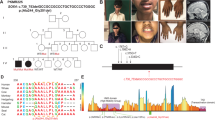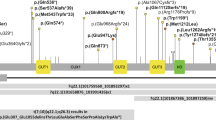Abstract
Dandy-Walker malformation (DWM; OMIM #220200) is a common but poorly understood congenital cerebellar malformation in humans. Through physical mapping of 3q2 interstitial deletions in several individuals with DWM, we defined the first critical region associated with DWM, encompassing two adjacent Zinc finger in cerebellum genes, ZIC1 and ZIC4. Mice with a heterozygous deletion of these two linked genes have a phenotype that closely resembles DWM, providing a mouse model for this malformation.
Similar content being viewed by others
Main
DWM is defined by hypoplasia and upward rotation of the cerebellar vermis and cystic dilation of the fourth ventricle1,2. Affected individuals often have motor deficits such as delayed motor development, hypotonia and ataxia; about half have mental retardation; and some have hydrocephalus. Many other abnormalities have been described in DWM, such as agenesis of the corpus callosum, visual deficits and epilepsy, but these are uncommon3. DWM is a heterogeneous disorder that has been associated with several malformation syndromes and cytogenetic abnormalities, although no specific genes have yet been implicated in its pathogenesis4. The low empiric recurrence rate of ∼1–2% for nonsyndromic DWM suggests that mendelian inheritance is unlikely and that a polygenic model may be more appropriate5.
We identified seven individuals with de novo interstitial deletions of chromosome 3q. Magnetic resonance imaging or computed tomography scans of these individuals show that they all have isolated DWM with hypoplasia and upward rotation of the cerebellar vermis and a posterior fossa cyst, although with variable expressivity (Fig. 1a and Supplementary Table 1 online). Typical of DWM, the cerebellar hemispheres are less affected than the vermis. Three of these individuals also have hydrocephalus. All seven have substantial cognitive deficits owing to the size of their deletions. Three have large deletions that include 3q22.2 and have facial changes of the blepharophimosis-ptosis-epicanthus inversus syndrome, presumably due to codeletion of the gene FOXL2 (ref. 6). Six of the seven individuals were initially recruited into this study because of their cytogenetic abnormalities and were then found to have DWM. The other individual (LR03-317) presented with signs of DWM and, on further analysis, was found to have a small 3q deletion. We mapped the sizes and locations of the seven deletions by extensive fluorescence in situ hybridization analysis on metaphase chromosomes and identified a 7-Mb critical region for DWM (Fig. 1b–g). BACs RP11-635I23 at 3q24 and RP11-167H9 at 3q25.1 define the centromeric and telomeric boundaries of this critical region, respectively.
All five have hypoplasia of the cerebellar vermis (most severe in b; least severe in f), large fluid collections in the posterior fossa and widely open communication between the 4th ventricle and the fluid collection. The severity of the malformation does not correlate with the size of the deletion. (g) Diagram of the eight interstitial deletions. Data from individuals LR03-317 and LR01-273 established the centromeric and telomeric boundaries, respectively, of the 7-Mb critical region. Data from individual LR01-325 defined the centromeric boundary of the smaller, 1.9-Mb critical region.
We narrowed the critical region by fine-mapping of the breakpoints in an eighth individual previously reported to have DWM and interstitial deletion of 3q24-3q25.33 (ref. 7; Supplementary Fig. 1 online). The centromeric boundary of this deletion, defined by BAC RP11-639B1, falls in the 7-Mb critical region that we identified. Thus, this breakpoint defines a smaller, 1.9-Mb critical region between RP11-639B1 and RP11-167H9 that contains only 13 genes (according to the University of California Santa Cruz human genome browser). None of these genes are good candidates for involvement in cerebellar development, either because phenotypes reported in humans or mice with mutations in these genes lack cerebellar involvement or because the genes have nonrelevant expression patterns during cerebellar development (refs. 8–10 and data not shown). In contrast, two good candidate genes for involvement in DWM, ZIC1 and ZIC4, are located 250 kb centromeric to the 1.9-Mb critical region. These tightly linked C2H2 zinc finger transcription factors are vertebrate homologs of Drosophila melanogaster odd-paired. Zic1 has a role in cerebellar development in mice11,12,13. Targeted homozygous null Zic1 mutant mice have severe cerebellar hypoplasia with folial mispatterning. Zic4 was initially identified in mice based on its homology to Zic1 but has not been characterized14. We found that mouse Zic4 was expressed in the dorsal central nervous system, including the developing cerebellum and spinal cord, in a pattern that overlaps with expression of Zic1 (Supplementary Fig. 2 online). Both ZIC1 and ZIC4 were hemizygous in seven of eight individuals with deletions of 3q, and expression of both genes was altered by the adjacent deletion in the other individual (LR01-325), as determined by semiquantitative RT-PCR analysis of lymphoblast mRNA (Supplementary Fig. 3 online).
To model DWM of individuals with 3q deletions, we generated a targeted deletion in mouse embryonic stem cells, encompassing the first exons of Zic1 and Zic4, which are closely linked on mouse chromosome 9. We also generated a targeted null mutation in Zic4 to determine whether it is required for cerebellar development (Fig. 2 and Supplementary Methods online). We used Zic1+/− mice for phenotypic comparison11. As previously described, the cerebellum in Zic1+/− mice appeared grossly normal, although sagittal sections through the vermis showed disruption of anterior folia15 (Fig. 2h). Zic4+/− mice had a distinct cerebellar phenotype of posterior cerebellar hypoplasia (Fig. 2i) in addition to a milder anterior foliation defect. Zic1+/− Zic4+/− mice fell into two distinct phenotypic classes: ∼85% had a mild cerebellar phenotype, similar to that of Zic1 heterozygotes, and 15% were severely affected, with marked foliar defects and disproportionate hypoplasia of the vermis compared to the hemispheres, mimicking the cerebellar morphology of individuals with DWM and deletions of 3q. In wild-type and Zic4+/− mice, the width of the vermis was 91% of the width of the hemispheres (Supplementary Fig. 4 online). Zic1+/− mice had a slightly smaller vermis (81% of the width of the hemispheres), like mildly affected Zic1+/− Zic4+/− mice (76% of the width of the hemispheres). In contrast, severely affected Zic1+/− Zic4+/− mice had a markedly smaller vermis (66% of the width of the hemispheres) and did not survive past weaning. Their average body weight was 45% (n = 12) of that of their wild-type littermates, and they had classic dysfunctional cerebellar phenotypes, such as failure to attain a normal righting reflex by postnatal day 10 and ataxia. These phenotypes were not obvious in either singly heterozygous mutants or mildly affected Zic1+/− Zic4+/− mice.
(a) Targeting strategies to generate a null Zic4 allele and double null Zic1 and Zic4 alleles. The Zic4 targeting vector replaced the coding region of the first exon of Zic4 with a neo cassette flanked by loxP sites. The double null Zic1 Zic4 targeted alleles replaced the entire 17.6-kb region between the two genes as well as the coding region of the first exon of Zic4 and the entire first exon of Zic1. (b–k) Cerebellar phenotypes of Zic1+/−, Zic4+/− and compound heterozygous Zic1+/− Zic4+/− mice. (b–f) Dorsal views of brains of mice at postnatal day 22 fixed in 4% paraformaldehyde in phosphate-buffered saline, with cerebellar fissures highlighted by dilute India ink. (g–k) Hematoxylin and eosin staining of 8-μm midsagittal sections through the vermis of brains of mice at postnatal day 22 fixed in Bouin's solution. Arrows indicate the primary fissure, dividing the anterior and posterior regions of the cerebellum. The wild-type cerebellum (g) has a stereotypic foliation pattern, which is disrupted in the heterozygous mutants. In Zic1+/− mice, the cerebellum (h) is slightly hypoplastic, with smaller anterior lobes. In Zic4+/− mice, the cerebellum (i) is also hypoplastic, with a distinct foliation abnormality in the posterior cerebellum especially visible as an invagination at the secondary fissure (arrowhead). The phenotypes of most Zic1+/− Zic4+/− mutants are comparable to that of Zic1+/− mice (j), but 15% of these double heterozygotes have severe cerebellar hypoplasia (k). In these mice, the vermis is reduced in width and has a simplified foliation pattern, lacking one entire anterior lobe.
We localized the first locus involved in DWM, which encompasses the genes ZIC1 and ZIC4 on chromosome 3q2. The high penetrance of the cerebellar phenotype in humans and mice, and the phenotype of the Zic1+/− Zic4+/− heterozygous mutant mice, supports that idea that these genes have an important role in cerebellar development. These data indicate that heterozygous loss of Zic1 and Zic4 is sufficient to cause DWM-like cerebellar vermis hypoplasia in mice. We conclude that heterozygous loss of ZIC1 and ZIC4 is the cause of DWM in individuals with deletion of 3q2. The low empiric recurrence risk in humans and the variable expressivity observed in both humans and mice also support the idea that modifying loci influence the malformation. Ongoing studies are aimed at investigating the proportion of human DWM that is associated with 3q2 and the developmental basis of this common cerebellar malformation.
Informed consent was obtained from all participants in the study under a protocol approved by The University of Chicago Institutional Review Board.
GenBank accession numbers. Human ZIC1 mRNA, NM_003412; human ZIC4 mRNA, AK094286; mouse Zic1 mRNA, BC063247; mouse Zic4 mRNA, NM_009576; critical region BACs, AC131210, AC117386 and AC021861.
Note: Supplementary information is available on the Nature Genetics website.
References
Patel, S. & Barkovich, A.J. Am. J. Neuroradiol. 23, 1074–1087 (2002).
Parisi, M.A. & Dobyns, W.B. Mol. Genet. Metab. 80, 36–53 (2003).
Maria, B.L. et al. Pediatr. Neurosci. 13, 45–51 (1987).
Chitayat, D. et al. Am. J. Med. Genet. 52, 406–415 (1994).
Murray, J.C. et al. Clin. Genet. 28, 272–283 (1985).
Crisponi, L. et al. Nat. Genet. 27, 159–166 (2001).
Sudha, T. et al. Clin. Dysmorphol. 10, 193–196 (2001).
Anikster, Y. et al. Nat. Genet. 28, 376–380 (2001).
Chen, X. et al. Am. J. Physiol. 272, F299–F304 (1997).
Shim, H. & Harris, Z.L. J. Nutr. 133, 1527S–1531S (2003).
Aruga, J. et al. J. Neurosci. 18, 284–293 (1998).
Aruga, J. et al. Dev. Biol. 244, 329–341 (2002).
Ebert, P.J. et al. Development 130, 1949–1959 (2003).
Aruga, J. et al. Gene 172, 291–294 (1996).
Aruga, J. et al. J. Neurosci. 22, 218–225 (2002).
Acknowledgements
We thank the affected individuals and their families for their participation, P. Soriano for providing the pPGKneo DTA vector and E. McNally and C. Roe for discussions and reading the manuscript. This work was supported by a Ragins-Goldsmith Fellowship and the Medical Scientist Training grant (to I.G.), a grant from the Brain Research Foundation of Chicago (to K.J.M.) and grants from the National Institute of Health (to K.J.M. and W.B.D.).
Author information
Authors and Affiliations
Corresponding author
Ethics declarations
Competing interests
The authors declare no competing financial interests.
Supplementary information
Supplementary Fig. 1
Axial CT scan from patient LR01-325. (PDF 82 kb)
Supplementary Fig. 2
In situ analysis showing Zic1 and Zic4 expression in the developing CNS, including the developing cerebellum. (PDF 165 kb)
Supplementary Fig. 3
Altered expression of ZIC1 and ZIC4 in patient LR01-325. (PDF 78 kb)
Supplementary Fig. 4
Vermis as a percentage of hemisphere width for each genotype at P22. (PDF 51 kb)
Supplementary Table 1
Phenotype summary of patients with del 3q2. (PDF 2 kb)
Rights and permissions
About this article
Cite this article
Grinberg, I., Northrup, H., Ardinger, H. et al. Heterozygous deletion of the linked genes ZIC1 and ZIC4 is involved in Dandy-Walker malformation. Nat Genet 36, 1053–1055 (2004). https://doi.org/10.1038/ng1420
Received:
Accepted:
Published:
Issue Date:
DOI: https://doi.org/10.1038/ng1420
This article is cited by
-
A vertebral skeletal stem cell lineage driving metastasis
Nature (2023)
-
Wisconsin syndrome with brain volume laterality: a case report and review of the literature
Journal of Medical Case Reports (2022)
-
DNA methylation landscapes from pig’s limbic structures underline regulatory mechanisms relevant for brain plasticity
Scientific Reports (2022)
-
The Cerebellar Gene Database: a Collective Database of Genes Critical for Cerebellar Development
The Cerebellum (2022)
-
The First 50 Years of Postnatal Neurogenesis in the Cerebellum: a Long Journey Across Phenomena, Mechanisms, and Human Disease
The Cerebellum (2022)





